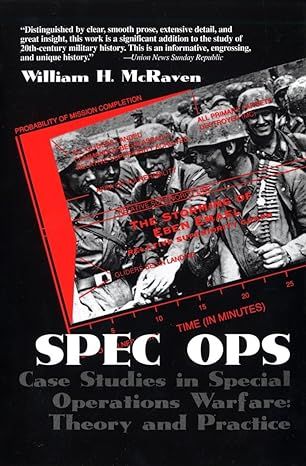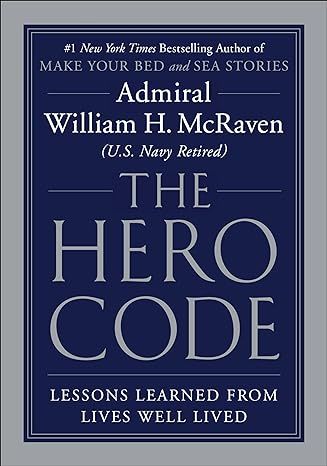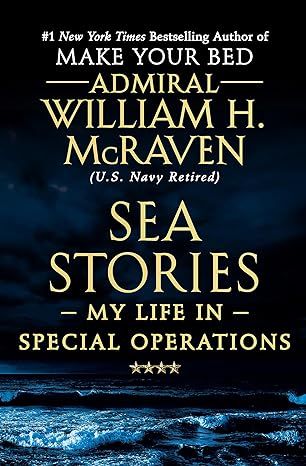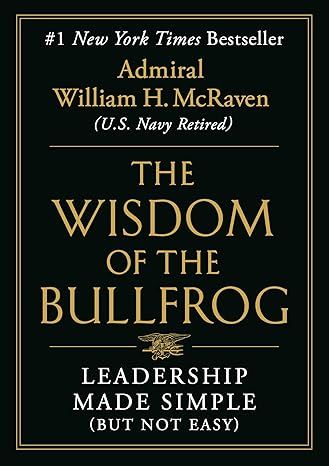Spec Ops: Case Studies in Special Operations Warfare: Theory and PracticeKindle
4.6
-
714 ratings
Vice Adm. William H. McRaven helped to devise the strategy for how to bring down Osama bin Laden, and commanded the courageous U.S. military unit that carried it out on May 1, 2011, ending one of the greatest manhunts in history. In Spec Ops, a well-organized and deeply researched study, McRaven analyzes eight classic special operations. Six are from WWII: the German commando raid on the Belgian fort Eben Emael (1940); the Italian torpedo attack on the Alexandria harbor (1941); the British commando raid on Nazaire, France (1942); the German glider rescue of Benito Mussolini (1943); the British midget-submarine attack on the Tirpitz (1943); and the U.S. Ranger rescue mission at the Cabanatuan POW camp in the Philippines (1945). The two post-WWII examples are the U.S. Army raid on the Son Tay POW camp in North Vietnam (1970) and the Israeli rescue of the skyjacked hostages in Entebbe, Uganda (1976). McRaven—who commands a U.S. Navy SEAL team—pinpoints six essential principles of “spec ops” success: simplicity, security, repetition, surprise, speed and purpose. For each of the case studies, he provides political and military context, a meticulous reconstruction of the mission itself and an analysis of the operation in relation to his six principles. McRaven deems the Son Tay raid “the best modern example of a successful spec op [which] should be considered textbook material for future missions.” His own book is an instructive textbook that will be closely studied by students of the military arts. Maps, photos.
Kindle
$14.99
Available instantly
Hardcover
$24.00
Paperback
$17.23
Spiral-bound
$31.96
Ships from
Amazon.com
Payment
Secure transaction
ISBN-10
0891416005
ISBN-13
978-0891416005
Print length
432 pages
Language
English
Publisher
Presidio Press
Publication date
May 31, 1996
Dimensions
5.96 x 0.94 x 8.96 inches
Item weight
1.1 pounds
Product details
ASIN :
B0024NP5FG
File size :
13553 KB
Text-to-speech :
Enabled
Screen reader :
Supported
Enhanced typesetting :
Enabled
X-Ray :
Enabled
Word wise :
Enabled
Editorial reviews
From Publishers Weekly
In this well-organized and deeply researched study, McRaven analyzes eight special operations. Six are from WWII: the German commando raid on the Belgian fort Eben Emael (1940); the Italian torpedo attack on the Alexandria harbor (1941); the British commando raid on Nazaire, France (1942); the German glider rescue of Benito Mussolini (1943); the British midget-submarine attack on the Tirpitz (1943); and the U.S. Ranger rescue mission at the Cabanatuan POW camp in the Philippines (1945). The two post-WWII examples are the U.S. Army raid on the Son Tay POW camp in North Vietnam (1970) and the Israeli rescue of the skyjacked hostages in Entebbe, Uganda (1976). McRaven?who commands a U.S. Navy SEAL team?pinpoints six essential principles of "spec ops" success: simplicity, security, repetition, surprise, speed and purpose. For each of the case studies, he provides political and military context, a meticulous reconstruction of the mission itself and an analysis of the operation in relation to his six principles. McRaven deems the Son Tay raid "the best modern example of a successful spec op [which] should be considered textbook material for future missions." His own book is an instructive textbook that will be closely studied by students of the military arts. Maps, photos.-- should be considered textbook material for future missions." His own book is an instructive textbook that will be closely studied by students of the military arts. Maps, photos.
Copyright 1995 Reed Business Information, Inc.
About the Author
Admiral William H. McRaven (U.S. Navy Retired) served with great distinction in the Navy. In his thirty-seven years as a Navy SEAL, he commanded at every level. As a Four-Star Admiral, his final assignment was as Commander of all U.S. Special Operations Forces. He is now Chancellor of the University of Texas System.
Read more
Sample
Excerpt. © Reprinted by permission. All rights reserved.
Theory of Special Operations
In the realm of military literature, there is much written on theory of war, ranging from Herman Kahn’s thinking about the unthinkable on the nuclear end of the spectrum to B. H. Liddell Hart’s indirect warfare on the conventional end. There are theories of war escalation and war termination, theories of revolution and counterrevolution, and theories of insurgency and counterinsurgency. There are general airpower and sea power theories, and more specific theories on strategic bombing and amphibious warfare. Nowhere, however, is there a theory of special operations.
Why is a theory of special operations important? A successful special operation defies conventional wisdom by using a small force to defeat a much larger or well-entrenched opponent. This book develops a theory of special operations that explains why this phenomenon occurs. I will show that through the use of certain principles of warfare a special operations force can reduce what Carl von Clausewitz calls the frictions of war to a manageable level. By minimizing these frictions the special operations force can achieve relative superiority over the enemy. Once relative superiority is achieved, the attacking force is no longer at a disadvantage and has the initiative to exploit the enemy’s weaknesses and secure victory. Although gaining relative superiority doesn’t guarantee success, it is necessary for success. If we can determine, prior to an operation, the best way to achieve relative superiority, then we can tailor special operations planning and preparation to improve our chances of victory. This theory will not make the reader a better diver, flyer, or jumper, but it will provide an intellectual framework for thinking about special operations. The relative superiority graph that will be shown later is a tool to assess the viability of a proposed special operation.
THE SCOPE OF THIS STUDY
To develop a theory of special operations I had to first limit the scope of the problem. This required developing the following refined definition of a special operation: “A special operation is conducted by forces specially trained, equipped, and supported for a specific target whose destruction, elimination, or rescue (in the case of hostages), is a political or military imperative.”*
My definition is not consistent with official joint doctrine which broadly defines special operations to include psychological operations, civil affairs, and reconnaissance. The eight combat operations I analyzed to determine the principles of special operations and to develop the theory are more closely aligned to what Joint Pub 3–05 defines as a direct-action mission.† Unlike direct-action missions, however, the eight special operations that I analyze in this book were always of a strategic or operational nature and had the advantage of virtually unlimited resources and national-level intelligence. The refined definition also implies that special operations can be conducted by non-special operations personnel, such as those airmen who conducted James Doolittle’s raid on Tokyo or the submariners involved in the raid on the German battleship Tirpitz. Although I believe the theory of special operations, as presented in this book, is applicable across the spectrum of special operations, as defined by Joint Pub 3–05, it was developed solely from the eight case studies presented in this work. All usage of the term special operations henceforth will adhere to this refined definition.
WHY ARE SPECIAL OPERATIONS UNIQUE?
All special operations are conducted against fortified positions, whether a particular position is a battleship surrounded by anti-torpedo nets (the British midget submarine raid on the German battleship Tirpitz), a mountain retreat guarded by Italian troops (Otto Skorzeny’s rescue of Benito Mussolini), a prisoner of war (POW) camp (the Ranger raid on Cabanatuan and the U.S. Special Forces raid on Son Tay), or a hijacked airliner (the German antiterrorist unit [GSG-9] hostage rescue in Mogadishu). These fortified positions reflect situations involving defensive warfare on the part of the enemy.
Carl von Clausewitz, in his book On War, noted, “The defensive form of warfare is intrinsically stronger than the offense. [It] contributes resisting power, the ability to preserve and protect oneself. Thus, the defense generally has a negative aim, that of resisting the enemy’s will … if we are to mount an offensive to impose our will, we must develop enough force to overcome the inherent superiority of the enemy’s defense.”2 Clausewitz’s theory of war states that to defeat “the stronger form of warfare” an army’s best weapon is superior numbers. “In this sense superiority of numbers admittedly is the most important factor in the outcome of an engagement, so long as it is great enough to counterbalance all other contributing circumstances. It thus follows that as many troops as possible should be brought into the engagement at the decisive point.”
No soldier would argue the benefit of superior numbers, but if they were the most important factor, how could 69 German commandos have defeated a Belgian force of 650 soldiers protected by the largest, most extensive fortress of its time, the fort at Eben Emael? How can a special operations force that has inferior numbers and the disadvantage of attacking the stronger form of warfare gain superiority over the enemy? To understand this paradox is to understand special operations.
RELATIVE SUPERIORITY
Relative superiority is a concept crucial to the theory of special operations. Simply stated, relative superiority is a condition that exists when an attacking force, generally smaller, gains a decisive advantage over a larger or well-defended enemy. The value of the concept of relative superiority lies in its ability to illustrate which positive forces influence the success of a mission and to show how the frictions of war affect the achievement of the goal. This section will define the three basic properties of relative superiority and describe how those properties are revealed in combat.
Relative superiority is achieved at the pivotal moment in an engagement. For example, in World War II, when the Germans attacked the Belgian fort at Eben Emael, they achieved a decisive advantage—relative superiority—over the enemy within five minutes of the initial engagement by using gliders and shaped charges to gain surprise and speed to subdue the enemy quickly. Although the Belgians fought for another twenty-four hours, the battle hinged on the first few moments, and the outcome of the engagement was virtually assured.
In some cases, the pivotal moment comes before actual combat. In 1943 the British modified an old destroyer, the HMS Campbeltown, filled it with four and a quarter tons of explosives, covered it with armor plating, sailed it across the English Channel, and rammed it into the German-held dry dock at Saint-Nazaire, France. This action rendered the dry dock useless for the remainder of the war. Although the German defenses surrounding Saint-Nazaire were the heaviest in the Atlantic, once the HMS Campbeltown managed to reach the outer harbor of the port (two miles from the dry dock), the Germans could not stop her. At this point, which was prior to actual hostilities, relative superiority was achieved. The point at which relative superiority is achieved is also frequently the point of greatest risk. The closer the attacking force gets, the tougher the defenses become. However, once you overcome the last obstacle the probability of success strongly outweighs the probability of failure, and relative superiority is achieved.
Once relative superiority is achieved, it must be sustained in order to guarantee victory. In an effort to rescue the Italian dictator Benito Mussolini, SS Capt. Otto Skorzeny conducted a glider assault on an Italian stronghold on top of Gran Sasso peak in the Apennines Mountains. Within four minutes of landing, Skorzeny had stormed the hotel hideout and had Mussolini in his custody. At this point he had achieved relative superiority. However, for the mission to be successful, Skorzeny had to extract Mussolini from the mountaintop and ensure the dictator’s safe return to Rome. This interim period between grabbing Mussolini and mission completion required sustaining relative superiority. This was accomplished through boldness on Skorzeny’s part and by reinforcing the small commando force with conventional troops.
The ability to sustain relative superiority frequently requires the intervention of courage, intellect, boldness, and perseverance, or what Clausewitz calls the moral factors. For example, during World War II, Lt. Luigi Durand de la Penne, an Italian frogman, clandestinely entered Alexandria Harbor aboard a manned torpedo. He and his second diver overcame an antisubmarine net, depth charges, picketboats, pier security, and an antitorpedo net to reach the British battleship HMS Valiant. All they had to do was place explosives on the hull and the mission would have been successful. Unfortunately, as Durand de la Penne dove the manned torpedo under the HMS Valiant, the submersible gained ballast and sank into the mud. To make matters worse, his second diver lost consciousness and floated to the surface. Although physically exhausted from the long dive and freezing from the cold water seeping into his torn dry suit, Durand de la Penne spent the next forty minutes moving the torpedo into position under the HMS Valiant. Only through his tremendous perseverance and courage (two of the four moral factors) was he able to sustain relative superiority and complete the mission.
Read more
About the authors
William H. McRaven
Admiral William H. McRaven (U.S. Navy Retired) is the #1 New York Times bestselling author of Make Your Bed and the New York Times bestseller Sea Stories: My Life in Special Operations. In his thirty-seven years as a Navy SEAL, he commanded at every level. As a Four-Star Admiral, his final assignment was as Commander of all U.S. Special Operations Forces. After retiring from the Navy, he served as the Chancellor of the University of Texas System from 2015 to 2018. He now lives in Austin, Texas with his wife, Georgeann.
Read more
Reviews
Customer reviews
4.6 out of 5
714 global ratings
GB
5
good book
Reviewed in the United States on February 10, 2023
Verified Purchase
liked it
JJ Waldron
5
Fantastic read
Reviewed in the United States on December 7, 2018
Verified Purchase
“Spec Ops” is a great book for any military personnel. It gives an in depth look at special operations, but much of the book is applicable to any military operation. The case studies are entertaining and give a different approach than any other book I have read. Easy to read and highly addicting, I highly recommend it.
Muscovite
5
insightful outline of specops
Reviewed in the United States on May 7, 2015
Verified Purchase
This is in a great book. The author is well versed and personally experienced in special operations. I bought a copy several years ago through a book club. I got it for 1 cent :).... I read it twice and gave that copy to my son. I wanted to read it again and found that it is no longer in print. I saw some advertised pricings that were unbelievable. I found this copy for a reasonable price and I am happy to have it. The book is a great read for specops enthusiasts or even experienced operators. This copy does have some wear and some writing in it. However, the wear is reasonable and the writing is neat and readable, and I get the impression that the previous owner was using this book as a text for socio-political studies, so I am not to awfully disappointed with the noteage because It adds a little different character to this copy. In regard to context, the author draws the reader into the scene, details the event from concept to execution, and offers insight not found in a novel. I would recommend this book anyone interested in history but mostly for those seeking to understand the outline of specops thinking and planning.
Read more
D. Deaton
5
Excellent Book With a Direct Application to SWAT Operations
Reviewed in the United States on July 3, 2011
Verified Purchase
Those who are looking for gripping war stories or a Walter Mitty reading exerience should look elsewhere. This is a serious work meant for a professional audience.
The author does an excellent job of "trimming the fat" from Strategy and Tactics as they are normally applied to larger units and instead focuses on the "Six Principles of Special Operations." These are: Simplicity, Security, Repetition, Surprise, Speed, and Purpose. While each case study in this book focuses on military actions, the lessons and examples in this book are directly applicable to SWAT operations. The analytical processes and tactical procedures discussed in this work will help police officers triumph over dangerous criminals and save innocent lives.
The concepts in this book dovetail perfectly with modern SWAT doctrine as taught by the NTOA and other competent, professional SWAT organizations. It is a wonderful companion piece to the works of Sid Heal and John Kolman; especially if you are a SWAT Commander. If you have to plan, command, or conduct a hostage rescue operation, you will wish that you had read this book.
Read more
2 people found this helpful

Dr. Nancy L. Nicholson
5
Important reading for tracking the evolution of war making.
Reviewed in the United States on January 24, 2013
Verified Purchase
I give this five stars for its clarity, mutually consistent concepts and relevance, but would give it many more.
Admiral McRaven, by published accounts, was a major player in planning the raid that Seal Team Six made on the Usama Bin Laden compound. Other reviewers have gone into more detail than I will, but four items from its conceptual toolkit are useful to my discussion, focused on the mutable character of war making. I will use two accounts about the Bin Laden raid to illustrate some points related to the Admiral's book.
In my lifetime, war making has changed from the "conventional" army operations of WW2 to the Cold War of regional military efforts, to this era of "terrorist" war making. I refuse to name this use of collateral damage by "special human/technical weapons" as a "war on terror." It is dependent on media coverage of carnage wrought on budgets generally smaller than for conventional wars. War is made on a specific adversary, not on a method. SPEC OPS preceded its practical importance by more than a decade, a tribute to a brilliant analyst.
- McRaven's theory of special operations proposes "...a successful special operations defies conventional wisdom by using a small force to defeat a much larger or well-entrenched opponent."
- The smaller force relies on precision, stealth and speed to achieve "strategic advantage of relative superiority."
- McRaven defines special operations as "A special operation is conducted by forces specially trained, equipped, and supported for a specific target whose destruction, elimination, or rescue (in the case of hostages) is a political or military imperative."
- The ruling idea is from General Carl von Clauswitz' "frictions of war" (chance, uncertainty and will of the enemy). This "friction" is an emergent property of the interactions of nonlinear outcomes from a number of sources in the combat arena. It would be helpful here to get and to read (if not already at hand) Clauswitz' "On War" to be familiar with his trinitarian analysis.
There are many books available on the Bin Laden raid. Each has a somewhat different account, according to published reviews. I have two of them: Mark Owen's "No Easy Day" and "SEAL Target Geronimo: The Inside Story of the Mission to Kill Osama bin Laden." Of the two, "SEAL Target" is the more credible account for me, as its described sequence of the raid near Abbottabad does not damage the "strategic advantage/relative superiority" of McRaven's planning by losing its stealth at the beginning with a helicopter crash. I commend you to McRaven's Figure 1-1 Sample Relative Superiority Graph. Its time line goes from "point of vulnerability" to six hours, with a radical change of risk at about 2.5 hours. As the remainder of the book explains, this is a complex type of multilevel systems undertaking based on competency with an amazing array of weapons, accurate intelligence (human and technical), courage and character (not necessarily in that order). Those who are members of elite military teams are aware of Murphy's Law. Or, as Clauswitz points out, "The greater the magnitude of any event, the wider the range of forces and circumstances that affect it." It is imperative to have creative backups to Plan A.
Bin Laden raid books are easily available for comparison of accounts of an event where some critical details will necessarily remain hidden. As Macchiavelli pointed out, "When little is known, much is suspected." Readers should examine various versions of the raid on Bin Laden in the light of learning about the budgeting and planning expenses of this species of "black operations" war. I am reminded of variations in some important official accounts in my lifetime, starting with the Eisenhower administration's handling of the Francis Gary Powers U2 incident, the Warren Commission Report on the assassination of President Kennedy, the Reagan Administration raid on Grenada* and now the current administration's accounts of the Bin Laden raid. The movie "Zero Dark Thirty" is not a subject of this review.
Stories groups craft to explain their actions may tell more about them than if they were transparent about their assertions. Mc Raven's book is a useful place to start to understand the "learning curve" that underlies a history of wars. This review would get even longer if I suggested more history of war or art/science of war books. But "SEAL Target Geronimo" recommends "The Book of Five Rings" or the Way of the Warrior by Miyamoto Musashi (translated by Jo Han-sun). "Leaders must exercise it, soldiers must know it. No one living really knows all there is to know about strategy."
*This raid was a textbook case of "Cold War geopolitical chess." Get out a map of the Caribbean and technical specs of MiG 23 aircraft in terms of flight radius with bases on eastern Cuba, El Salvador and finally, Grenada. With the third southern piece of the puzzle under Soviet control, economic and strategic shipping in the Caribbean and Panama Canal Zone could have been interdicted at will.
Read more
8 people found this helpful
Top William H. McRaven titles
View allBest Sellers
View all
The Tuscan Child
4.2
-
100,022
$8.39

The Thursday Murder Club: A Novel (A Thursday Murder Club Mystery)
4.3
-
155,575
$6.33

Sapiens: A Brief History of Humankind
4.6
-
140,302
$13.49

The Butterfly Garden (The Collector, 1)
4.3
-
88,556
$9.59

Things We Hide from the Light (Knockemout Series, 2)
4.4
-
94,890
$11.66

The Last Thing He Told Me: A Novel
4.3
-
154,085
$2.99

The Perfect Marriage: A Completely Gripping Psychological Suspense
4.3
-
143,196
$9.47

The Coworker
4.1
-
80,003
$13.48

First Lie Wins: A Novel (Random House Large Print)
4.3
-
54,062
$14.99

Mile High (Windy City Series Book 1)
4.4
-
59,745
$16.19

Layla
4.2
-
107,613
$8.99

The Locked Door
4.4
-
94,673
$8.53





